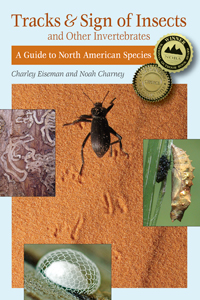I’m about two months behind in sorting my photos. I just made it to the morning of June 1, when I was at a campground in Cumberland Gap National Historical Park in Virginia. Here is one of the first faces I saw that morning:
I don’t have anything profound to say about this, other than that horse flies have really nice eyes. So do deer flies, which are in the same family. Take, for instance, this one from Massachusetts, which is in the process of depositing the egg mass that is shown on page 56 of Tracks & Sign of Insects:
And while I’m on the subject of fancy fly eyes, how about this mosquito I found in my garage back in February:
So even the most annoying biting flies have some redeeming features.







So beautiful. Thanks Charley!
Stunning photos! Can you tell us anything about the anatomy and physiology of those eyes? They are beautiful, but I would love to know why they are the way they are.
Well, I did a little searching and I found this article: http://www.springerlink.com/content/t234g4601268h8g7/ …The first page is free, but it costs $35 to read the rest! I’ll let you know if I learn anything else.
Some more thoughts on fly eyes here: http://bugguide.net/node/view/552597
Awesome shots – did you use the 65mm or extension tubes?
Thanks! These are with the 65mm (except the deer fly was with a Nikon 105mm). I don’t own any extension tubes, but I’ve been curious to try some on top of the 65mm. Scott Justis has posted some amazing shots of mites and springtails on BugGuide using that setup.
I can’t resist saying that your first photo is an eyeful.
This is the second blog I’ve encountered recently that includes photos taken with the Canon 65mm macro lens. I’m getting tempted. I currently use the “regular” Canon 100mm.
Steve Schwartzman
http://portraitsofwildflowers.wordpress.com
If the Canon 100mm is like the Nikon 105mm, something that takes some getting used to with this lens is how close you have to be to your subject. At the lowest magnification (field of view = 22 mm), the front of the lens is about 3 inches from the subject. There is no focus ring, so you just have to be this distance away. So it’s pretty unusual to be able to get a shot like this of something like a horse fly, and when you do manage to do it, the depth of field is extremely shallow. If you want to take pictures of really tiny things that don’t move very fast, though, I recommend it!
The working distance of the Canon 100mm is much longer and includes a focus ring (although I tend to leave it fixed in place and “rock” back and forth for fine focus). The longer working distance is better in terms of not spooking subjects so easily, but I’ve become of the opinion that I’d rather have the shorter working distance because of the greater apparent light size and resulting decrease in specular highlights from the full flash. Many of my latest photos are with the 100mm stacked on extension tubes, not for increased mag but to decrease the working distance, and I’m much happier with them. I use my knowledge of insect behavior to get them accustomed to my presence and allow me to get closer for the shots.
Of course, when the insect really is small enough to warrant, I like to break out the 65mm!
Interesting, Ted–I had noticed how nice and diffuse the light is on those shiny beetles on your most recent post, and was wondering what you were using for those. What kind of diffuser setup do you use? I haven’t gotten around to experimenting with homemade diffusers yet, but I’m pretty sure we’d be seeing distinct white rectangles if I had taken those photos.
My MT-24EX flash diffuser. I started using this setup at the beginning of the year, but only with the 100mm. With the 65mm I use Puffers+Sto-Fens.